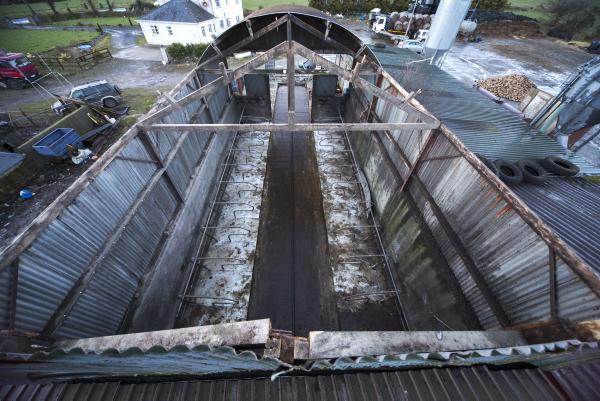At the lower end of the scale are loss of small numbers of cladding sheets, roof light sheets and doors, and tree limbs falling on to sheds. However, in counties along the west, where some of the worst winds were experienced, there have been cases of complete roofs blown off and sheds falling over.
Most of the sheds which suffered major damage were 30 and 40 years old, had timber rafters and trusses in the roof, had corrosion on metal trusses and/or were on exposed sites.
There are fewer reports of damage to sheds built in the past 15 years, especially where built under a grant scheme to Department of Agriculture specifications. These sheds would have been built using stronger materials, would have all necessary roof bracing and the components have not yet corroded.
Newer sheds that suffered damage generally did not have roof bracing and had fewer than recommended fixing nails or screws in the cladding.
In a small number of cases, shed walls made of concrete blocks have been blown over and injured cattle.
“I’ve seen a big upsurge in damage to sheds since the start of the year,” said Peter Mooney of Mooney Farm Buildings, based in Slane, Co Meath. He has done some repair work to cladding and has made secure a number of more badly damaged shed roofs – they will be repaired in better weather.
The common problems are clear sheet roof lights being blown off and gable ends on older sheds becoming unattached. “The clear lights are obviously more vulnerable given that they are not made of steel. They break up around the nail and once that happens they will flail in the wind and blow off. I spent Saturday fixing back on clear lights. They are about two and a half times more expensive than steel cladding but most farmers value the light so they will replace them.
“Replacing these sheets requires loosening the adjacent sheets on all four sides. You need someone inside to push them up while you slide in the new sheet. It’s almost a job for three men. And we have to pick our time – you can’t lift sheets in wind.”
Gable ends are suffering damage because they catch the full force of wind.
“Generally, the sheds we are seeing with big damage are from the 1930s to the 1950s. The timbers may have been untreated. The sheeting has corroded, letting in water. The timbers then rotted and now they have snapped. We were called to one shed where the roof was left just hanging on. We stripped and left it safe until we can get back.”
He has also been asked to provide a quote for replacing a shed which was “levelled” for insurance purposes.
Clare
“A number of older sheds have been completely destroyed,” said Cooraclare farm building contractor Declan Fennel. “Roofs are gone and cattle are out in the open. I know one incident where cattle were killed by a falling wall.” He has been booked to build new sheds to replace a number of older sheds that were lost.






 This is a subscriber-only article
This is a subscriber-only article





SHARING OPTIONS: